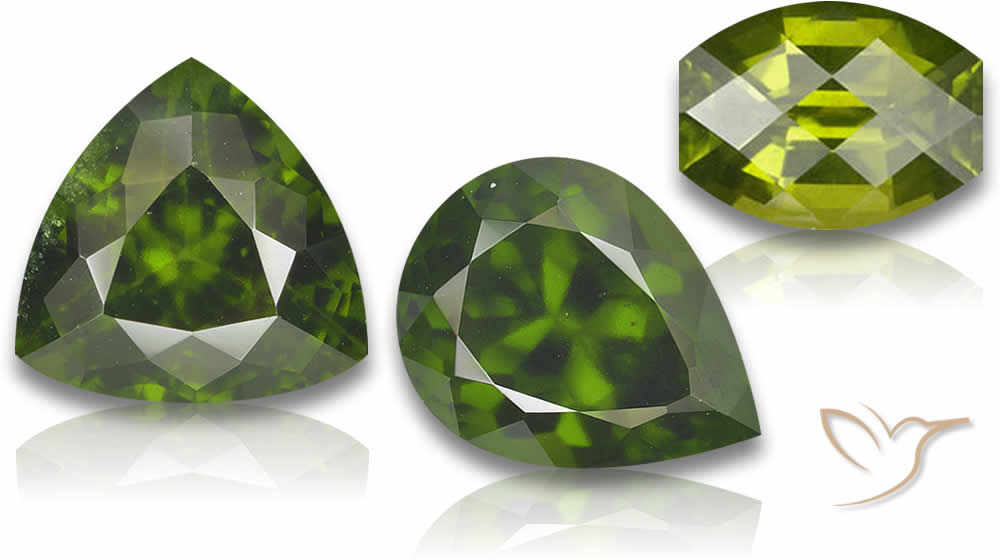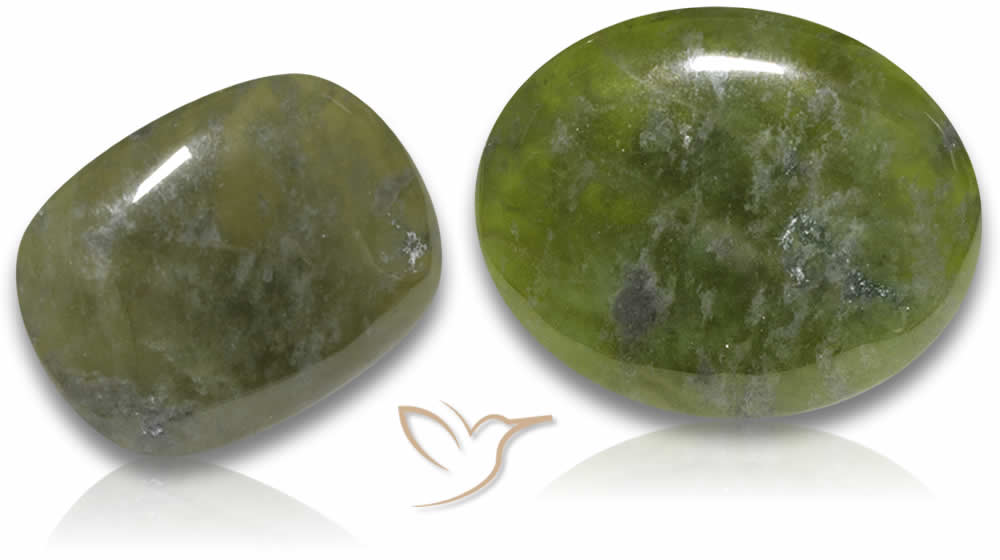Idocrase Gemstone Information & Essentials

Idocrase, also known as Vesuvianite, is a striking gemstone celebrated for its vibrant green, yellow, and brown hues. Named after the famous Mount Vesuvius in Italy, where it was first discovered, this gemstone boasts a unique crystal structure and is prized for its beauty and rarity. In this article, we will delve into the origins, properties, and uses of Idocrase (Vesuvianite), exploring why it continues to be a sought-after gemstone in both the gemological and metaphysical worlds. Discover our collection of loose Idocrase for sale.
Key Takeaways
- Idocrase gemstones are a fascinating group of gemstones with unique properties and meanings.
- They come in a range of colors, and each variety has its own unique attributes.
- Idocrase gemstones are believed to offer a range of benefits, including emotional balance, enhanced intuition, and spiritual growth.
- Caring for your idocrase jewelry is crucial to preserving its longevity and beauty.
- Exploring the different varieties and origins of idocrase gemstones can deepen your appreciation of this unique gemstone family.
Idocrase Meaning and Symbolism
Idocrase Vesuvianite gemstones hold deep symbolism and meaning, making them treasured by many wearers. It is believed that idocrase gemstones possess powerful qualities that benefit the wearer both physically and emotionally.
According to crystal healers, idocrase gemstones promote a sense of peace and tranquility, fostering the balance of emotions and enhancing intuition. It is said that idocrase can awaken a sense of adventure and curiosity in those who wear it, inspiring a deeper appreciation for the world around them.
Idocrase gemstones are also believed to offer physical benefits, such as relief from stress and tension, and support for the immune system. Some also believe that idocrase can help balance hormones and reduce inflammation in the body.
Whether you seek idocrase for its emotional or physical benefits, this gemstone is sure to add depth and meaning to your collection.
Idocrase Gemstone Properties
Idocrase gemstones possess unique properties that make them stand out from other gemstones. Here are some interesting facts about idocrase gemstones:
| Property | Description |
|---|---|
| Color | Idocrase gemstones come in a variety of colors, including green, yellow, brown, and black. The color is due to the presence of iron and chromium. |
| Transparency | Idocrase gemstones have a translucent to opaque appearance, depending on the variety and quality of the stone. |
| Hardness | Idocrase gemstones have a hardness of 6.5 on the Mohs scale, making them suitable for jewelry that will not be subjected to excessive wear and tear. |
| Formation | Idocrase gemstones are formed from crystalline rocks found in metamorphic deposits. |
| Composition | The chemical composition of idocrase gemstones is calcium titanium silicate, with the addition of iron, aluminum, and other trace elements. |
These unique properties make idocrase gemstones a popular choice for jewelry designers who want to create pieces that stand out from the crowd. The stunning color variations and interesting composition of idocrase gemstones make them a fascinating gemstone to learn about and appreciate.
Idocrase Gemstone Varieties
Idocrase, also known as vesuvianite, is a fascinating gemstone with a wide range of varieties and origins. Here, we will introduce you to some of the most popular idocrase gemstone varieties and the regions where they are found.
Cyprus Vesuvianite
This variety of idocrase is found in the mountains of Troodos, Cyprus, and is characterized by its vivid green color. The gemstone is also known as Troodos stone and is highly sought after for its unique hue.
California Vesuvianite
California is another location where idocrase is found. This variety is typically brown or yellow, with occasional green hues. California idocrase is typically smaller in size than other varieties but is highly valued for its unique color variations.
Italian Vesuvianite
This variety of idocrase is found in various locations within Italy and is characterized by its strong and vibrant green color. Italian idocrase is highly prized among gemstone collectors and is often used in high-end jewelry pieces.
Canadian Vesuvianite
Canadian idocrase is known for its deep green hue and is found primarily in Quebec, Canada. This variety is highly regarded for its transparency and is often used for faceted gemstone cuts.
Swiss Vesuvianite
Swiss idocrase is another highly sought after variety and is found primarily in the Valais region of Switzerland. This gemstone is characterized by its bright and vibrant green color, with occasional brown or yellow hues. Swiss idocrase is often used in high-end jewelry pieces due to its exceptional clarity and luster.
Mexican Vesuvianite
Mexican idocrase is found primarily in the state of Jalisco and is characterized by its vibrant and lustrous green color. This variety is highly sought after by gemstone collectors and is often used in statement jewelry pieces.
Origin of Idocrase Gemstones
In addition to the aforementioned locations, idocrase is also found in various regions throughout the world, including Austria, the Czech Republic, Russia, and Tanzania. The exact origin of idocrase gemstones can impact their color, clarity, and overall value, making them a popular choice among collectors.
Idocrase Gemstone Colors
Idocrase, also known as vesuvianite, offers a beautiful range of colors for those who appreciate unique gemstones. The most common color for idocrase is green, which can vary from a light yellow-green to a vibrant forest green. Other colors of idocrase include brown, yellow, red, blue, and sometimes even purple.
The color of idocrase is influenced by various factors, including the presence of specific minerals and the location where it was mined. For example, idocrase found in Italy may exhibit a different hue than idocrase found in Quebec.
What makes idocrase colors unique is that they often display a range of different tones, giving the gemstone a three-dimensional effect. Some idocrase may even exhibit color zoning, with different areas of the gemstone displaying different colors or intensities.
Whether you prefer a bright green hue or a more subdued earthy tone, idocrase offers a diverse color palette that is sure to impress.

Idocrase Gemstone Healing Properties
Idocrase gemstones are believed to possess powerful healing properties that have been recognized for centuries. The energy that these stones provide is said to help balance emotions, promote physical well-being, and enhance intuition and spiritual growth.
Through the chakras, idocrase gemstones are thought to stimulate the heart, throat, and third eye centers, allowing for a deeper connection to the self and opening up channels for positive energy to flow throughout the body.
Wearing idocrase stones is also said to aid in stress relief, promote inner peace, and offer protection against negative energy. Additionally, idocrase is believed to improve communication, increase confidence, and encourage self-expression.
Idocrase Healing Properties: At a Glance
| Emotional Healing | Helps balance emotions, promote inner peace, and relieve stress. |
|---|---|
| Physical Healing | Provides protection from negative energy and promotes well-being. |
| Spiritual Healing | Increases intuition, encourages self-expression, and supports spiritual growth. |
Overall, idocrase gemstones are believed to provide a variety of healing properties that can support both physical and emotional well-being, making them an excellent choice for those looking to improve their overall health and happiness.
Caring for Idocrase Jewelry
Idocrase gemstones are a beautiful and valuable addition to any jewelry collection. Proper care is crucial to ensure their longevity and keep them looking their best.
Follow these tips to care for your idocrase jewelry:
Cleaning
Regular cleaning is essential to maintain the appearance of your idocrase jewelry. To clean it, gently wipe the gemstone with a soft, damp cloth. Avoid using harsh chemicals or ultrasonic jewelry cleaners, as they can damage the surface of the stone. When in doubt, consult a professional jeweler for cleaning services.
Storage
When not wearing your idocrase jewelry, store it in a cool, dry place away from direct sunlight. Avoid storing it with other jewelry pieces to prevent scratches and damage.
Protection
Idocrase gemstones are relatively hard and durable, but they can still scratch or chip. Avoid wearing your idocrase jewelry during activities that may cause excessive impact or scratches, such as gardening, sports, or cleaning with abrasive materials. When traveling with your idocrase jewelry, store it in a dedicated jewelry travel case or pouch to prevent damage during transit.
By following these tips, you can ensure that your idocrase jewelry continues to shine and sparkle for years to come.
Conclusion
Through our exploration of idocrase gemstones, we have uncovered a world of fascinating information and properties. From its meaning and symbolism to its formation and composition, idocrase is a gemstone that is rich in history and significance.
We have discovered the positive benefits that idocrase is believed to offer, including emotional balance, intuition enhancement, and spiritual growth. We have also learned about the importance of properly caring for and protecting idocrase jewelry to ensure its longevity and beauty.
The unique varieties and colors of idocrase gemstones make them a wonderful addition to any jewelry collection. Whether you're drawn to the vibrant greens or the earthy tones, there is an idocrase gemstone for everyone.
In conclusion, we hope that this exploration of idocrase gemstone information has provided you with valuable insights and appreciation for this unique gemstone. Remember to always care for and cherish your idocrase jewelry for years of enjoyment to come.
FAQ
What is the meaning of idocrase gemstone?
Idocrase gemstone, also known as vesuvianite, is believed to symbolize balance, harmony, and spiritual growth. It is associated with positivity, clarity, and breaking free from limitations.
What are the benefits of wearing idocrase gemstone jewelry?
Wearing idocrase gemstone jewelry is believed to bring emotional balance, enhance intuition, and support spiritual growth. It can promote positive energy, increase self-confidence, and attract abundance into one's life.
What are the properties of idocrase gemstones?
Idocrase gemstones come in various colors, including green, yellow, brown, and gray. They have a vitreous or glass-like luster and a hardness of around 6.5 on the Mohs scale. Idocrase gemstones are formed through the metamorphic process and are composed of calcium, aluminum, silicon, oxygen, and hydroxide ions.
What are the different varieties and origins of idocrase gemstones?
Idocrase gemstones can be found in various locations around the world, including Italy, Switzerland, Canada, and the United States. The different varieties include transparent, translucent, and opaque specimens, each exhibiting unique colors, such as green, brown, yellow, and gray. The color intensity and distribution can vary based on the gemstone's origin.
What colors can idocrase gemstones exhibit?
Idocrase gemstones can exhibit a range of colors, including vibrant shades of green, yellow, brown, and gray. Some specimens may display a combination of multiple colors, while others have a solid color throughout. The color intensity and hue can vary depending on the specific composition of the gemstone.
What are the healing properties of idocrase gemstones?
Idocrase gemstones are believed to have various healing properties. They are said to help balance emotions, release stress and anxiety, and promote a sense of calm and inner peace. Idocrase is also thought to enhance intuition, aid in decision-making, and support spiritual and personal growth.
How should I care for my idocrase jewelry?
To care for your idocrase jewelry, it is recommended to avoid exposing it to harsh chemicals and extreme temperatures. Clean your idocrase gemstone jewelry gently using mild soap and warm water, and dry it thoroughly with a soft cloth. Store your idocrase jewelry separately to prevent scratching and protect it from direct sunlight.

